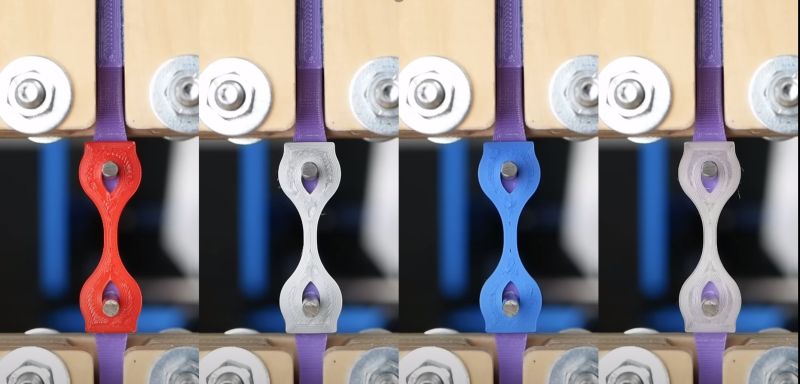What is an FDM filament coloring’s purpose but to be an aesthetic choice? As it turns out, the additives that create these changes in coloring and transparency also affect the base properties of the polymer, whether it’s PLA, PETG, or another material. This is where a recent video by [CNC Kitchen] is rather illustrative, using a collection of colored PLA filaments from a single filament manufacturer.
[CNC Kitchen] ran a range of tests including tensile strength, ductility, layer adhesion, impact resistance, and annealing performance. The results showed no clear overall winner between plain PLA polymer and any specific color. Perhaps most fascinating was just how much these color additives change the material’s response to annealing. Baking the PLA at 100°C for 30 minutes generally improves material properties, but also can cause warping and shrinking. The effective warping and shrinking differed wildly between the filament.
The general conclusion would seem to be that the natural polymer isn’t necessarily the optimal choice, but that you should test and pick the filament from a specific manufacturer to fit your project’s needs.
















I know that across the board red PLA has the most bed adhesion issues no matter the manufacturer. Blue seems to be the best. Took a ton of failed prints before I learned to add every trick when printing with red
I’ve had the opposite issue with red PETG, it stuck too well to the print surface, to the point I thought I was going to damage my bed trying to get it off. I had to heat the bed past the PETG recommended temp, and very carefully use a razor blade at all the corners until it finally popped loose. Now I just use a raft with red PETG, it’s more material but a better chance of not damaging the print.
I have to agree. I’ve been doing a series on cheap filament unboxing and tests. I purchase some the most no name, janky, wierd manufacturer names; as well as cheapest spools I can find. The results have really surprised me. Even well known name brands print horrible with red PLA/PLA+/PETG while the no name spools that are not red tend to print amazingly well. Better than I was expecting in fact.
Anyone with a bit of experience with printing functional parts knows this, or at least they should.
Still nice to see someone with a large following make it known for those who don’t.
I know nothing of 3D printing (sad, I know, but I’m an OldGuy™) but…is the pigment for most red filament the same? I know a fair bit about epoxies, and one can reduce or increase tensile strength substantially with different fillers. Pigments are essentially fillers.
I’ve never bothered with 3D printing, I am willing to pay a company to deal with the production issues and maintenance. But it surprises me if/that materials from large manufacturers are so poorly characterised that their datasheet doesn’t have basic mechanical data like tensile strength of a standardized test specimen (standard layer orientation and size etc) even between their own materials. I guess it’s down to the plethora of DIY folk who build random plastic action figures rather than using it for mechanically critical items, but it’s part of the reason I’m still wary of dabbling in myself – I don’t want to spend hours designing and printing a widget only to find it’s weak and useless, when I can send it to a commercial outfit and get a known performance. Good on the author for taking the time to characterise!
More expensive filaments do have tests done and the information provided per material but I’m not sure about per material color, I don’t think so.
On an unrelated but related note: Earlier today I was thinking if for simple design prints like lids and boxes and all such it would maybe make sense to get a prefab flat square of the filament material and print on top of that, so things would go much quicker and would be stronger since the bottom part was there already.
Perhaps they should sell solid squares of fixed size to put on the bottom of prints and then the printer could fuse them?
Just thinking out loud. Oh and I don’t own a 3D printer so excuse me if I suggest an impossible thing.
That’s actually a really great idea!
It makes little sense as how is one to adhere this to the printing surface and even worse is the z offset issue.
I have been in 3D printing for nearly a decade.
This question has been on my mind for the last 5 years. I tried several colors by a bunch of manufacturers and basic gray has been, for me, to be the best of all things, no matter the maker, followed by black and the darkest blue colors.
I print all functional pieces in gray.
Gray also is the best, in my opinion, in showcasing printing problems. Nearly all machine makers include white as their sample. No wonder. White hides nearly all problems.
Exact same experience here. I only buy gray.
For me it’s been white as far as impact strength goes but it also gets brittle on the spool when old.
@Art Haglund But gray is so lifeless.
That’s why they make paint ;)
Yes, this article is fact because I knew from past experiences with thing’s like paint and epoxy mixing that the more “additives ” aka color the less the base resin can show its true colors(adhesion) pun intended. Now this is because some colors such as grey mentioned earlier only needs trace amounts of black and white to make true grey , while red isn’t just red it requires significant amount of white and possibly others to make a true opaque red to the eye.